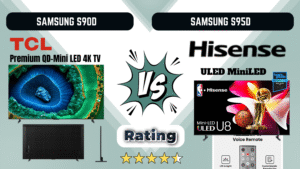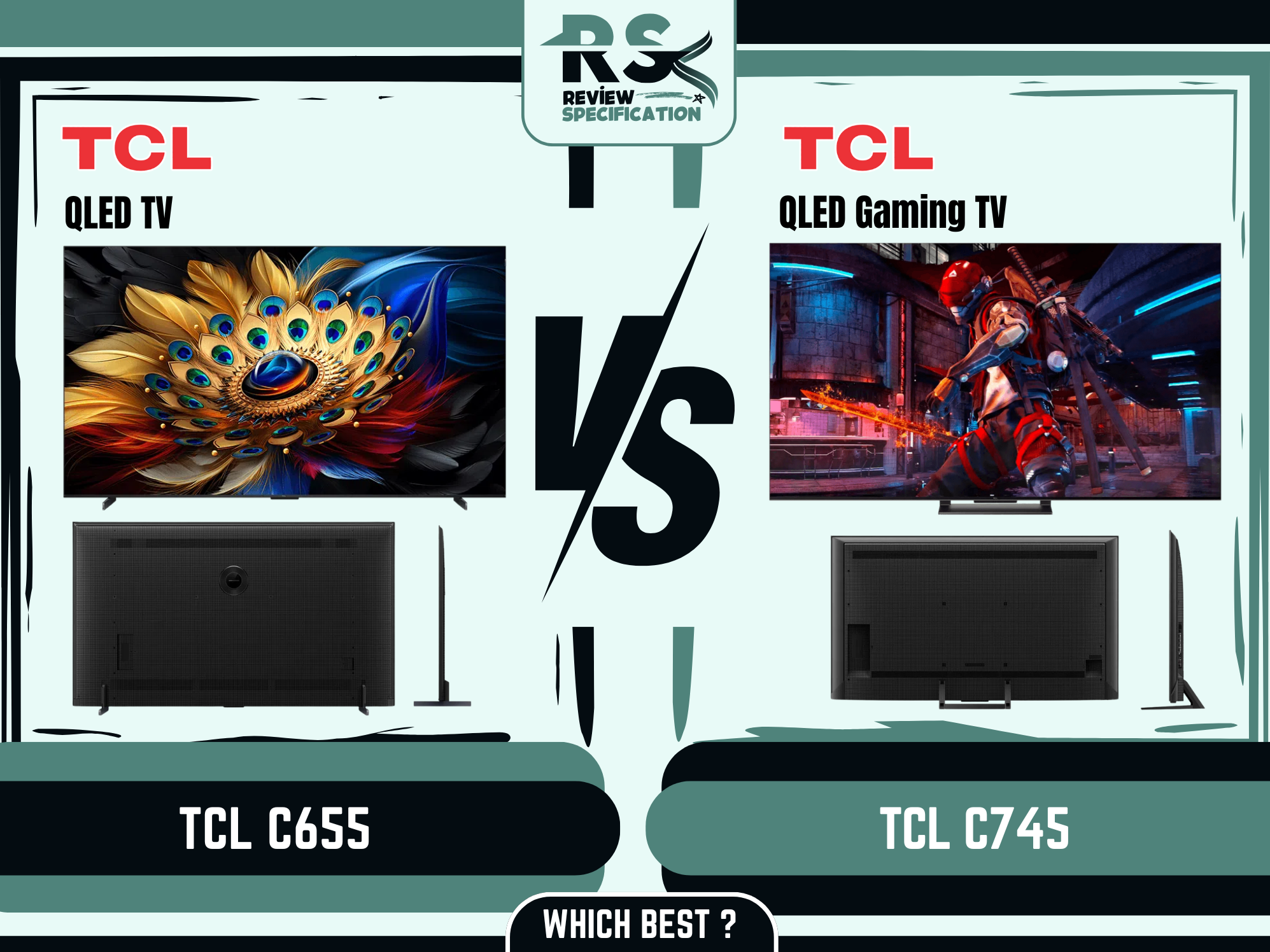
TCL C855 vs Hisense U8N Which Best: Ultimate Mini LED TV Showdown in 2025
Are you on the lookout for purchasing a premium Mini LED TV that offers ultimate image quality, excellent sound, and the most advanced gaming features? The TCL C855 and Hisense U8N are two of the premium Mini LED TVs that offer incredible value to buyers seeking an elite-level viewing experience. In this all-around comparison of TCL C855 vs Hisense U8N Which Best, we will delve into everything ranging from display tech and performance to design and value to allow you to make a well-educated choice on which flagship TV is worth having in your living room.
Both of these flagship models employ state-of-the-art Mini LED technology, high refresh rates, and excellent HDR capabilities, but they also have several key differences that might make one more appropriate to your specific needs. Let’s take a close look at what makes each of these amazing TVs unique and determine which offers the best overall value.
Company Details & Release Information
| Model 1: TCL C855 | |
|---|---|
| Brand | TCL |
| Series | C Series (C855) |
| Year | 2024 |
| Available Models | 65″, 75″, 85″, 98″ |
| Model 2: Hisense U8N | |
| Brand | Hisense |
| Series | U Series (U8N) |
| Year | 2024 |
| Available Models | 65″, 75″, 85″ |
Full Specifications Comparison
| Features | TCL C855 | Hisense U8N |
|---|---|---|
| Build & Design | ||
| Design Style | Ultra Slim Design with magnetic mount capability | Premium Bezel-less Design |
| Cable Management | Yes, integrated | Yes |
| Display & Visuals | ||
| Panel Type | VA with QD-Mini LED | ULED with Mini-LED Pro+ |
| Resolution | 4K UHD (3840 × 2160) | 4K UHD (3840 × 2160) |
| Local Dimming Zones | Up to 2304 zones | Up to 2000+ zones |
| Peak Brightness | 3500 nits peak, 650 nits typical | Up to 3000 nits peak |
| Contrast Ratio | 6000:1 native, up to 35,000,000:1 dynamic | Not specified |
| Color Technology | QLED PRO with Quantum Dot (97% DCI-P3) | QLED Quantum Dot (1 billion+ colors) |
| Anti-Reflection | Low Reflection screen | Anti-Glare Low Reflection technology |
| HDR Support | Dolby Vision IQ, HDR10+, HDR10+ Adaptive, HLG | Dolby Vision, HDR10, HDR10+, HLG, Advanced HDR by Technicolor |
| Refresh Rate | 144Hz VRR | 144Hz VRR |
| Special Certifications | IMAX Enhanced | IMAX Enhanced, Filmmaker Mode |
| Performance & Processing | ||
| Processor | AiPQ PRO PROCESSOR | Hi-View Engine PRO |
| AI Features | Ai-CONTRAST, Ai-CLARITY, Ai-COLOR, Ai-MOTION, Ai-HDR, Ai-SCENE | Dynamic Tone Mapping Pro, Face Detection, AI HDR/Detail Enhancement |
| Motion Enhancement | Ai-MOTION | MEMC with 480 Motion Rate |
| Sound & Audio | ||
| Audio System | 2.2.2 Channel (65″/75″: 2.1.2) | 2.1.2 Channel |
| Total Power | Up to 120W (2×10W main + 2×10W subwoofer + 2×10W up-firing) | 60W max power |
| Audio Technology | ONKYO tuned, Dolby Atmos, DTS-HD + DTS Virtual:X | Dolby Atmos |
| Smart Features & Software | ||
| Operating System | Google TV | Google TV |
| Voice Control | Hands-free Voice Control with Google Assistant | Voice Control with Google Assistant |
| Video Chat | Yes | Not specified |
| Gaming Features | ||
| Gaming Mode | Game Master 2.0 | Game Mode Pro |
| VRR Range | 48-144Hz | 48-144Hz |
| FreeSync | AMD FreeSync Premium Pro | AMD FreeSync Premium Pro |
| ALLM | Yes | Yes |
| Gaming Features | 4K@144Hz, HDMI 2.1 support | 4K@144Hz, HDMI 2.1 support, Game Bar, Low Latency MEMC |
| Connectivity & Ports | ||
| HDMI Ports | 4 (2× HDMI 2.1 + 2× HDMI 2.0) | 4 (2× HDMI 2.1 4K@144Hz + 2× HDMI 2.0) |
| USB Ports | Multiple (not specified) | Yes (not specified) |
| Wi-Fi | Wi-Fi 6 | Wi-Fi 6E |
| Bluetooth | Bluetooth 5.2 | Bluetooth 5.0 |
| TV Tuner | Not specified | ATSC 3.0 (NextGen TV) |
| eARC/ARC | Yes | Yes |
| Digital Audio Output | Yes | Yes |
| Price & Availability | ||
| Price Range | Premium Range ($1000-$3000 depending on size) | Premium Range ($1000-$3000 depending on size) |
| Availability | Widely available in major retailers | Widely available in major retailers |

Overall Rating
| Category | TCL C855 | Hisense U8N |
|---|---|---|
| Picture Quality | ⭐⭐⭐⭐⭐ (5/5) | ⭐⭐⭐⭐⭐ (5/5) |
| Sound Quality | ⭐⭐⭐⭐½ (4.5/5) | ⭐⭐⭐⭐ (4/5) |
| Gaming Performance | ⭐⭐⭐⭐⭐ (5/5) | ⭐⭐⭐⭐⭐ (5/5) |
| Smart Features | ⭐⭐⭐⭐½ (4.5/5) | ⭐⭐⭐⭐ (4/5) |
| Design | ⭐⭐⭐⭐⭐ (5/5) | ⭐⭐⭐⭐ (4/5) |
| Value for Money | ⭐⭐⭐⭐½ (4.5/5) | ⭐⭐⭐⭐½ (4.5/5) |
| Overall Score | ⭐⭐⭐⭐⭐ (4.75/5) | ⭐⭐⭐⭐½ (4.42/5) |
Customer Feedback Reviews
| Aspect | TCL C855 | Hisense U8N |
|---|---|---|
| User Rating | 4.7/5 | 4.5/5 |
| Positive Comments | “Exceptional brightness and contrast” “Outstanding gaming performance” “Premium build quality” “Great value for high-end features” |
“Impressive picture quality” “Excellent HDR performance” “Intuitive smart features” “Filmmaker Mode is excellent” |
| Negative Comments | “Software occasional glitches” “Premium price point” “Limited viewing angles” |
“Audio could be better” “Limited documentation” “OS not as smooth as competitors” |
Pros & Cons
TCL C855 Pros:
- Higher peak brightness (3500 nits vs 3000 nits)
- More precise local dimming with 2160 dedicated zones
- Superior ONKYO-tuned audio system with detailed specifications
- Six-crystal light-emitting chip technology for enhanced brightness
- Ultra-slim design with magnetic wall mount option
- Available in larger 98″ size option
- Google TV with hands-free voice control
- Comprehensive connectivity with 4 HDMI ports (2 × HDMI 2.1)
TCL C855 Cons:
- Generally higher price point across equivalent sizes
- VA panel may have more limited viewing angles
- Potentially higher power consumption due to extreme brightness
Hisense U8N Pros:
- Dynamic Tone Mapping PRO with up to 500,000 dimming zones
- Dedicated Filmmaker Mode for cinematic purists
- Total Ambient Adaptive technology for optimal viewing in any light
- Game Bar for real-time gaming metrics and adjustments
- Hi-Concerto technology for seamless soundbar integration
- Competitive pricing for premium features
Hisense U8N Cons:
- Lower peak brightness (3000 nits vs 3500 nits)
- Less detailed audio specifications available
- No 98″ size option for those wanting the largest screen
- Less comprehensive connectivity information available
Comparison Overview:
Comparing the TCL C855 and Hisense U8N to see which is best for varying needs, we must look at their main differences in various categories:
Picture Quality Comparison
The TCL C855 and Hisense U8N are both standout performers in the picture quality arena, using Mini LED technology in combination with quantum dots for colors and contrast. Still, TCL C855 takes a lead here with its 3500 nits peak brightness over Hisense U8N’s 3000 nits, making it possibly better for bright room viewing and HDR highlights. The C855 also has 2160 local dimming zones, which give full control of light for deep blacks and bright highlights.
On the other hand, Hisense boasts its Dynamic Tone Mapping PRO technology that promises 500,000 zones of dimming through frame-by-frame analysis using software. Practically speaking, that translates to both sets providing good contrast performance, although TCL might have a slight edge in sheer brightness for HDR content.
Audio Performance
Audio is an area where TCL C855 is more specific in its specifications using its ONKYO-tuned 2.2.2 channel system (60W overall power for big sizes), complete with dedicated up-firing speakers for Dolby Atmos content. Hisense U8N features a 2.1.2 multi-channel surround system supporting Dolby Atmos but with fewer published specs.
One of the distinctive benefits for the Hisense U8N is its Hi-Concerto technology, allowing effortless integration with Hisense soundbars for people wanting to complete their audio solution. Nevertheless, when it comes to integrated audio quality, the TCL C855 seems to win on the basis of published specifications.
Gaming Capabilities
Gamers will love both models, as the TCL C855 vs Hisense U8N review shows both TVs come with 144Hz variable refresh rate support, which makes them ideal for next-generation console and computer gaming. The TCL C855 has AMD FreeSync Premium Pro certification and Game Master 2.0 bundle, while Hisense responds with its Game Mode PRO and special Game Bar that shows real-time statistics.
Both sets support HDMI 2.1 features such as VRR, ALLM, and 4K@144Hz gaming, although TCL offers more precise details regarding its port arrangement with 2 × HDMI 2.1 and 2 × HDMI 2.0 ports. Either choice would benefit gamers, with the decision perhaps being a matter of personal preference regarding AMD FreeSync (TCL) or Hisense’s Game Bar interface.
Design and Build Quality
The TCL C855 highlights its ultra-slim uni-body construction with magnetic wall mount and cable management built-in, which makes it a great option for those concerned with looks and tidy installations. The Hisense U8N has a premium build with single stand design on all sizes, which is stable but perhaps not as streamlined as TCL’s.
Smart Features and User Experience
TCL relies on the tested Google TV platform with hands-free integration of Google Assistant, video calling, and a strong app store. Hisense’s intelligent platform is dedicated to content discovery and personalization, although less detail has been published regarding its individual operating system. For people already within the Google ecosystem, the TCL C855 might have superior integration of other smart devices within the home.
Size Options
If you want the biggest screen, the TCL C855 has a whopping 98″ option that the Hisense U8N cannot match, with the latter only going up to 85″. Both companies provide the common 65″, 75″, and 85″ sizes that are mainstream in the high-end TV market.
Final Verdict: TCL C855 vs Hisense U8N Which Best
After making a detailed comparison of the TCL C855 vs Hisense U8N to see which suits various viewing conditions best, we can safely conclude some things to assist you in making the ideal choice for your particular requirements.
Select the TCL C855 if:
-
You require the highest brightness level possible for very bright room viewing
-
You prioritize audio quality and won’t be using a soundbar
-
You need a 98″ size model
-
You cherish the end-to-end Google TV ecosystem with hands-free voice control
-
You like the ultra-slim form factor with magnetic wall mounting features
-
You’re a PC gamer using AMD and will appreciate FreeSync Premium Pro
Select the Hisense U8N if:
-
You’re a movie buff who will enjoy the exclusive Filmmaker Mode
-
You will integrate your TV with a Hisense soundbar through Hi-Concerto integration
-
You appreciate the Game Bar interface for in-game real-time stats and adjustments
-
Total Ambient Adaptive technology for auto picture adjustment matters to you
-
You’re seeking possibly superior value at every size point
Both the TCL C855 and Hisense U8N are the best of what is currently available in 2025 premium Mini LED TVs. The TCL C855 is our recommendation for the majority of users simply because its specs in brightness, sound, and connectivity options are slightly better, and its build is surprisingly thin. The Hisense U8N is still a great choice, though, especially for film aficionados who will love its Filmmaker Mode and ambient adaptive technology.
In making a choice between TCL C855 vs Hisense U8N that best meets your requirements, look at your viewing environment, type of content you watch, and whether you will be upgrading your audio setup. Both offer great performance that will meet even the most discerning viewer’s needs, so either one will be a great anchor for your home entertainment system.
Whichever that may be, you’ll have one of the finest Mini LED TVs on sale in 2025, complete with breathtaking images, immersive sound, and gaming features that won’t be eclipsed for many years to come.
FAQs: TCL C855 vs Hisense U8N
Is the TCL C855 better than the Hisense U8N for picture quality?
Both TVs offer impressive Mini LED visuals with quantum dot color, but the TCL C855 edges ahead thanks to its 3500 nits peak brightness versus 3000 nits on the Hisense U8N. The TCL also offers 2160 hardware-based dimming zones, whereas the Hisense relies on its Dynamic Tone Mapping PRO for software-driven contrast. For HDR highlights and bright-room viewing, TCL holds a slight advantage.
Which TV is better for gaming?
Both are excellent for gaming with 144Hz refresh rates and full HDMI 2.1 support. TCL offers Game Master 2.0 and AMD FreeSync Premium Pro, making it ideal for PC gamers. Hisense counters with Game Mode PRO and an intuitive Game Bar that provides real-time gaming stats. Either TV will excel, so your choice may depend on your ecosystem or preferred gaming interface.
Which has better built-in sound?
The TCL C855 is equipped with an ONKYO-tuned 2.2.2 speaker system (up to 60W), including up-firing Atmos speakers for a cinematic sound experience. The Hisense U8N also supports Dolby Atmos with a 2.1.2 speaker system, though it publishes fewer audio specs. TCL takes the lead in audio performance unless you’re pairing the Hisense with a soundbar using its Hi-Concerto integration.
How do the smart features compare?
TCL runs Google TV, offering seamless Google Assistant, video calling, and a vast app ecosystem. Hisense uses a proprietary OS focused on personalized content discovery but offers fewer ecosystem integrations. If you’re embedded in the Google ecosystem, TCL offers better smart home integration and app support.
Which TV is better for watching movies?
The Hisense U8N features Filmmaker Mode and Total Ambient Adaptive technology for adjusting picture settings based on room lighting—great for movie lovers. The TCL C855, however, offers higher brightness and superior contrast, enhancing HDR performance in well-lit rooms. Both are excellent, but Hisense slightly caters more to cinematic purists.
Do they come in the same sizes?
Mostly. Both TVs are available in 65″, 75″, and 85″ sizes. However, only TCL offers a massive 98″ variant, ideal for home theater setups. If screen size is a priority, TCL wins.
Which TV has better viewing angles?
Both use VA panels, known for excellent contrast but narrower viewing angles compared to IPS or OLED. Off-angle viewers might notice some color shifting. Neither excels in this area, so if wide-angle viewing is critical, consider OLED alternatives.
How do they handle reflections and glare?
The TCL C855 includes an Ultra-Low-Reflection Screen, while the Hisense U8N features Low Reflection Technology. Both minimize glare effectively, but TCL’s higher brightness gives it an edge in very bright rooms or those with direct sunlight.
Which TV is more energy efficient?
Energy usage isn’t fully detailed, but TCL’s higher brightness suggests slightly more power draw. Both use Mini LED, which is more efficient than older LED types. For accurate info, consult the official energy labels for your region and screen size.
Is there a big price difference?
Generally, Hisense aims to be more competitively priced, offering similar specs for slightly less money. However, actual prices vary by region, retailer, and promotions, so always compare models of the same size to get the best value.
How reliable are these TVs, and what are the warranties like?
Both brands have improved significantly in reliability, especially for their high-end models. Warranties typically span 1–2 years, but check with authorized retailers or the manufacturer’s site for specifics in your area.
Can these TVs be wall-mounted?
Yes. Both support standard VESA mounts. The TCL C855 also offers magnetic wall mounting for a flush, minimalist finish. Be sure to check the VESA pattern and weight capacity for your TV size.
Which has better upscaling performance?
The TCL C855 uses the AiPQ PRO Processor with advanced AI tools like Ai-CLARITY and Ai-COLOR. The Hisense U8N features the Hi-View Engine PRO with a Deep Neural Network for 4K upscaling. Both deliver excellent results, especially for 1080p content.
Which is better for bright room viewing?
The TCL C855 is superior, with 3500 nits brightness and better anti-reflective tech. Hisense’s ambient adaptive technology is useful, but TCL’s raw brightness helps in sun-filled spaces.
Do both TVs support all major streaming apps?
Yes. The TCL C855 (Google TV) offers nearly every major service: Netflix, Disney+, Prime Video, Apple TV+, YouTube, and more. The Hisense U8N also supports these apps, but availability may vary by region. TCL might be a better choice if you rely on niche or international apps.














Leave feedback about this